Sukhbaatar city (somewhat confusingly, it is also the name of an aymag/province on the other side of the country) is the last stop on the main Trans-Mongolian railway line before it crosses over to Russia. To be honest, a large part of the reason I traveled here is because it, unlike so many places in Mongolia, is easy to get to.
I took the night train from UB. Trains within Mongolia are cheap, so I took not the cheapest platzkartny bed but a spot in a 4-berth kupe compartment. The train
arrived at 4:30 in the morning, and after looking for one of the places listed in the Lonely Planet, I ended up staying at the train station hotel. It was actually fairly decent, as I got a small room on the 5th floor with a nice southern window. Since I was still tired after geeing 4 hours of sleep, I slept for a few hours. At around 8:00 there was loud and repeated knocking on my door for something like 5 minutes, and when I opened it there was a Mongolian soldier apparently asking if he could also sleep in my room. Because they charge different rates depending on how many are in the room, I gestured that I would have to check with the hotel attendant. And since I was going to get up and leave soon, I didn't want him in my room when I wasn't there, so I ended up refusing. I felt kind of bad, but it was a strange situation. Did I violate Mongolian hospitality? But if I did, shouldn't he have been able to find someone else to let him stay?
I went back to sleep for a little bit, then got up and spent a couple of hours walking around the city, after taking a shower. This was my introduction to the Russian practice at budget places of having to pay extra to unlock the shower. The toilets, of course, were free, but you had to go down to reception to get a key for the showers: about $1.
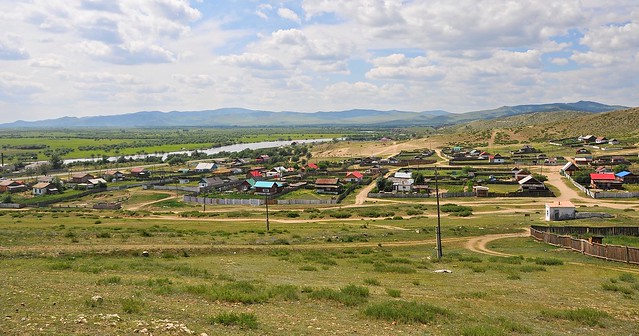 |
| A view of the residential area of town from one of the hills behind it. Tall wooden fences that completely enclose houses are the norm here. |
 |
| View from one of the hills, looking south. Given the location of the ger, I guess that the Orkhon river (the same one we saw in Kharkhorin) doesn't rise any higher. |
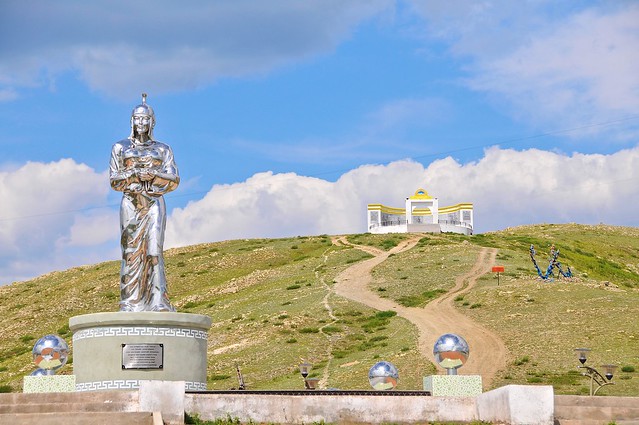 |
| A recently built park and monument on one of the hills. The design incorporates fountains, but they were predictably dry and empty. Most fountains in Mongolia are. Those shiny spheres were also majorly dented and banged up. A favourite pastime for some Mongolians is to get drunk (something like 25% of Mongolian men are alcohol dependent) and beat things up (often each other), so they really didn't stand much of a chance. |
 |
| Khatag prayer scarves cover what remains of this tree. |
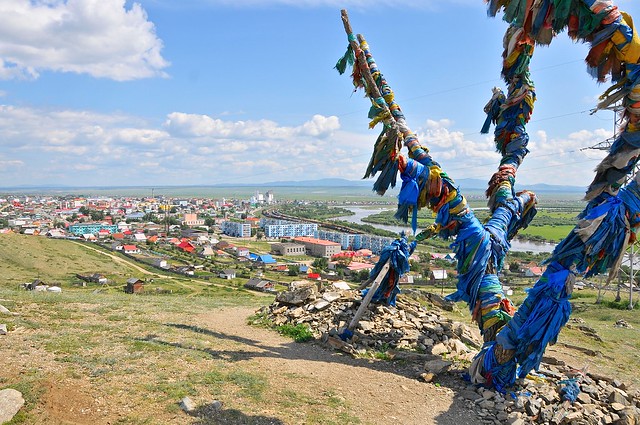 |
| Looking towards the city. Sukhbaatar seems pretty developed and liveable, compared to Kharkhorin. |
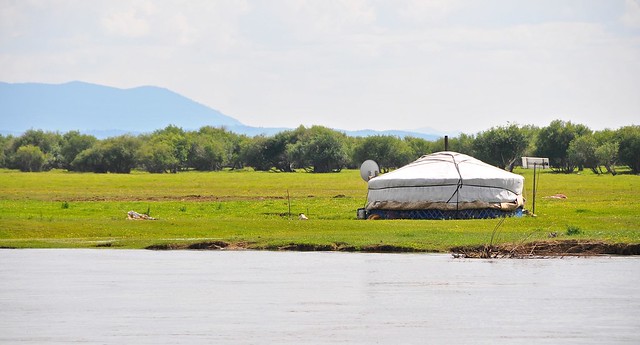 |
| Like most gers, this one has a satellite dish and a solar panel to power it. |
 |
| No satellite dish, but the presence of cattle suggests the owners aren't that poor. |
 |
| An abandoned Russian building in the area between the railway tracks and the Orkhon river. Pretty much all the buildings here were abandoned for some reason, despite appearing pretty nice. |
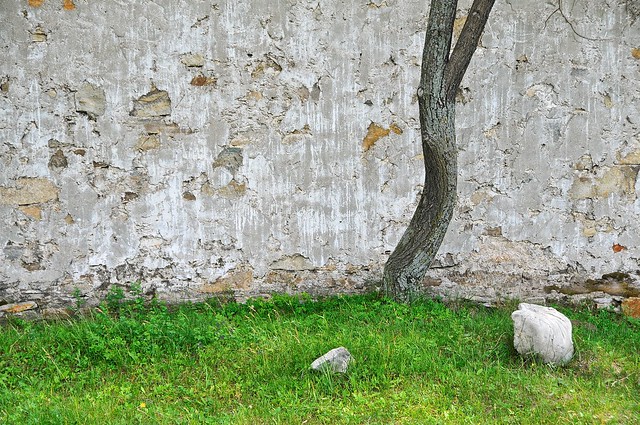 |
| A tree grows at the base of an abandoned building. |
 |
| Some cows decided to use one of the buildings. |
Eej Mod (Mother Tree)
The main attraction around Sukhbaatar is Eej Mod, or Mother Tree. Eej Mod is interesting to me because it doesn't really seem to fit in with what I understand to be Buddhism, as it seems clearly shamanistic or folk-religious in nature. It's the worship of a local spirit, and much of Mongolian religious expression seems to be like this, ranging from the ubiquitous
ovoo prayer mounds to trees and objects festooned with prayer scarves. I suppose that an outsider would see many similar inconsistencies within Christianity—such as the veneration of saints, let alone celebration of Hallowe'en, the Easter Bunny, Valentine's Day, and Christmas—but I'm not familiar enough with Buddhist traditions to make sense out of it.
Instead, it seems to me that Mongolian Buddhism is a mixture of Buddhism and shamanism, and I think that this combination is fairly typical of nomadic peoples who are highly dependent on the vicissitudes of nature. In central Asia, for example, the nomadic Kyrgyz and Kazakh are much more shamanistic than the sedentary, agricultural Uzbek.
Eej Mod is about 10 km south of Sukhbaatar, off the road to Darkhan & UB. There are no real signs pointing the way, but if you keep track of the km markers on the side of the road and count them off as you leave Sukhbaatar you can get a good idea of how far or close you are. Or just use your GPS maps.
I added Eej Mod and its access road to Google Maps, so it should be easy to find now.
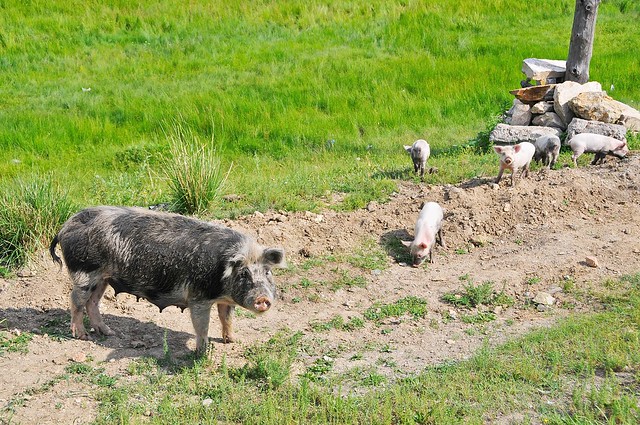 |
| A sow and her piglets just outside Sukhbaatar. Mongolians tend not to think much of pigs, and I think these are the only swine I saw there. |
 |
| A small ovoo prayer mound and tree by the road. |
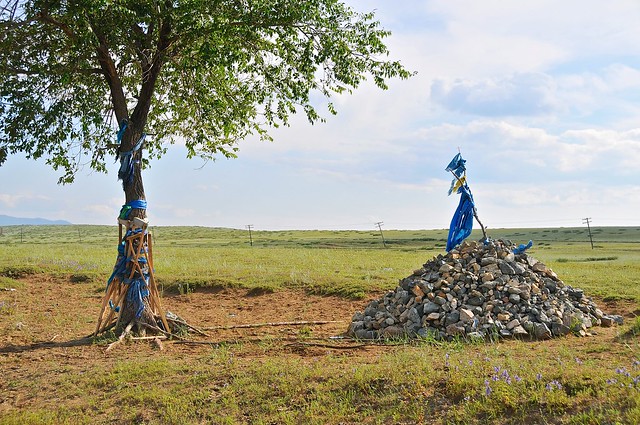 |
| I'm sure there's a story behind the crutches. |
 |
| A picture of the Dalai Lama is tucked into the khatag scarves. It's difficult for me to reconcile the nexus between these shamanistic practices and Buddhism, but Mongolians clearly see the connection. |
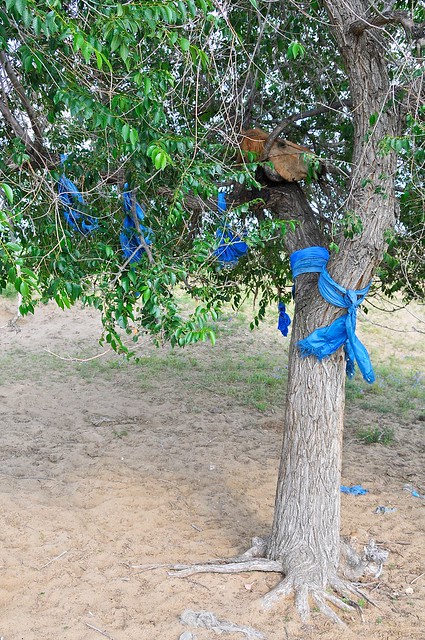 |
| A horse's head is nestled in the crook of a branch. This is done as a gesture of respect to the horse. The most disrespectful thing would be to leave its head and bones on the steppe, where they could be tread on. |
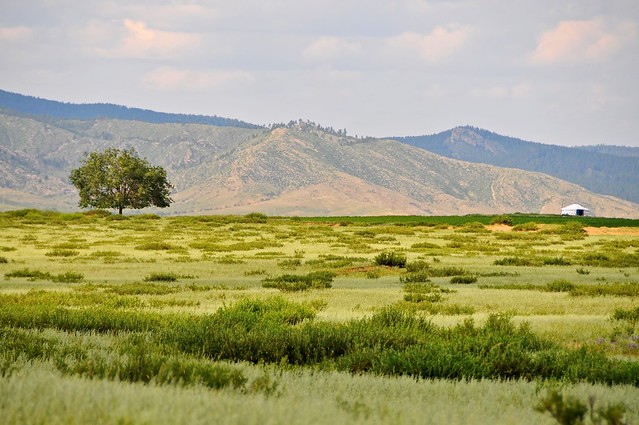 |
| Looking north. The patch of greenery by the ger is probably the only patch of cultivated land I saw in Mongolia. |
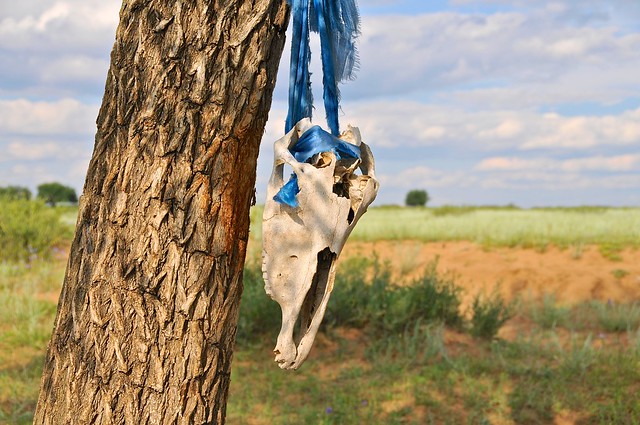 |
| A horse's skull hangs from another tree. |
 |
| As you get closer to Eej Mod you see more and more of the trees covered with scarves. |
 |
| Doesn't seem to matter what kind of tree. |
 |
| Eej Mod is on a bluff overlooking the river and train tracks to the west. |
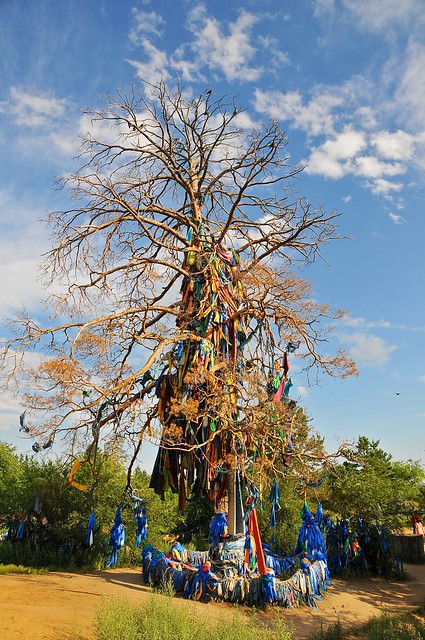 |
| This is Eej Mod, as seen from the back. Only a very few parts of the tree actually seem to be alive. |
 |
| This is the previous Mother Tree, burned during the communist revolution. The bricks in front of it are blocks made of tea rejects (stems and unsuable leaves), while there is a sulde spirit banner in the background. Other popular offerings include milk, vodka, and matches, as well as miniature solar-operated prayer wheels. |
 |
| Matches as offerings. |
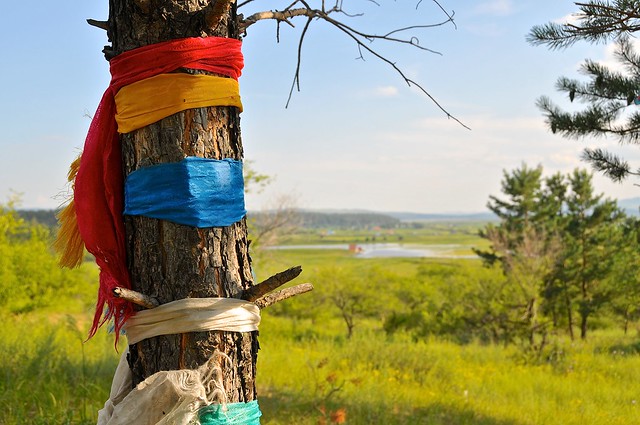 |
| Overlooking the river. |
 |
| The access road to Eej Mod is lined with scarves. |
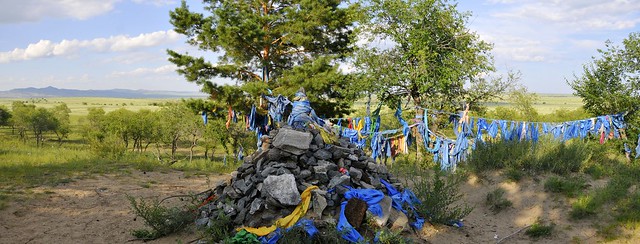 |
| An ovoo prayer mound at the edge of the woods. |
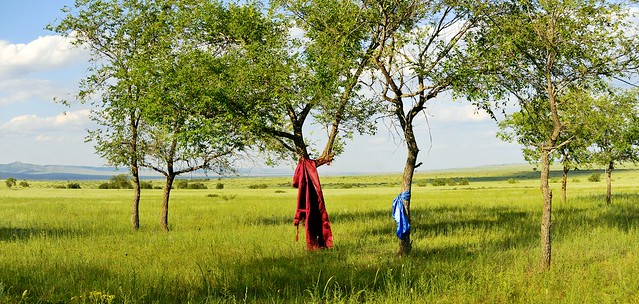 |
| Monk's robes as the woods meet the steppe. |
 |
| A family of weasels or polecats just outside Eej Mod. |
 |
| They were very wary of me, but interesting to watch. |
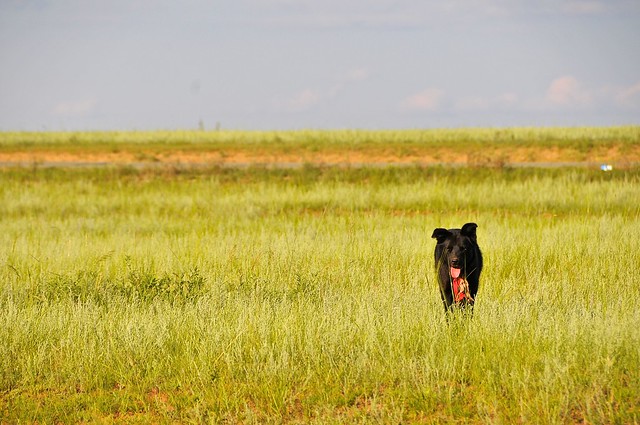 |
| You have to be careful of Mongolian dogs, as some take their guard-dog duties seriously and can be quite vicious. Although was wearing a scarf and seemed friendly, it's always a good idea to pick up a rock when you see a dog: they know what it means, even if you don't intend to use it. |
 |
| Shrine and tree by the main road. |
 |
| See the bottle of milk? It's often sprinkled on altars, and the prayer scarves are frequently covered with it. Take it from me, spoiled fermented milk products don't smell particularly great. |
 |
| View from the main road. Eej Mod lurks in the woods behind. |
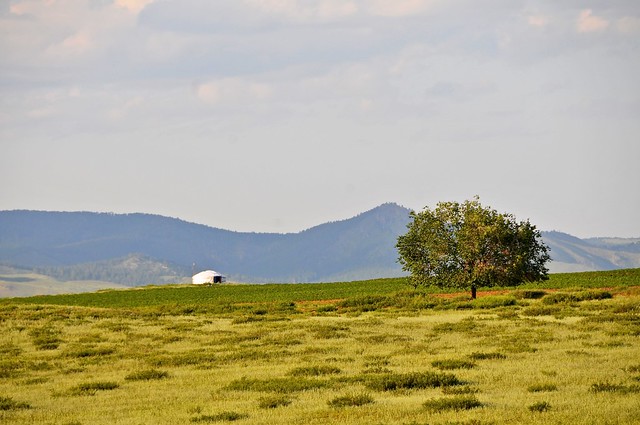 |
| On the way back to town. |
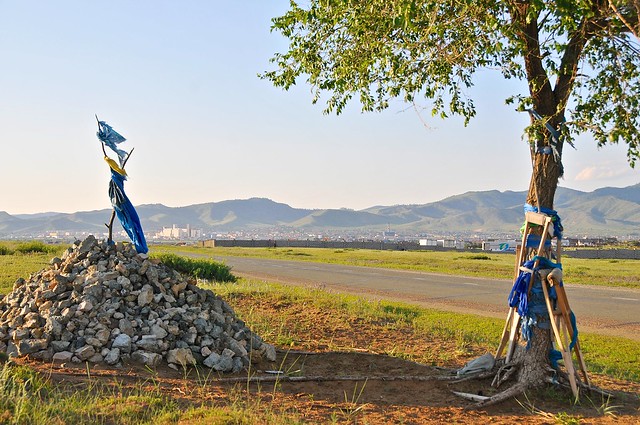 |
| This familiar ovoo prayer mound is about halfway to Eej Mod. |
I really enjoyed Eej Mod and the walk there. Sure, it was three hours of walking there and back, but the weather was great and the day was warm. It's really the weather and season that makes it so enjoyable, as visiting on a rainy day or even a month or so later, when the grass is brown and dead, would have made it so much less enjoyable. I'm lucky to have picked a perfect time to visit.
Altanbulag
Altanbulag is a border town about 25 km northeast of Sukhbaatar, which itself is about 15 km south of the border. It's as close as I came to Russia on my trip, but the only thing you can really see is the exterior of a Russian Orthodox church. Since there's not much to do in Sukhbaatar, it's a good way to spend a few hours, especially since it has the regional museum.
 |
| Russian church and border tower, as seen from the Mongolian side. |
 |
| That strip of dirt marks the border, just east of Altanbulag. |
 |
| Access road for border patrols. |
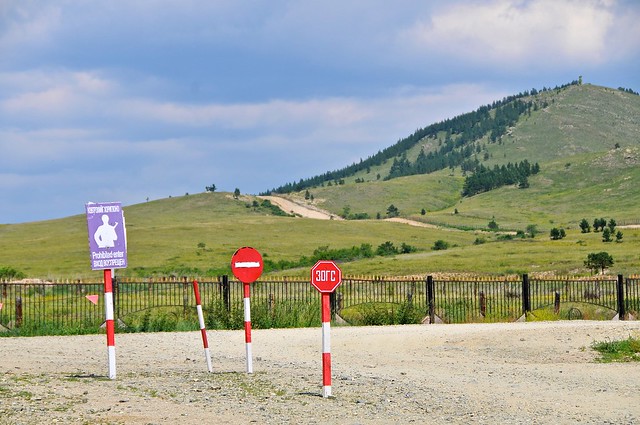 |
| The border zone. |
 |
| Mongolian park next to the border. It looks more like an abandoned lot, filled with dirt and weeds, while the pond on the left is covered with algae and scum, with the odd plastic bottle for effect. |
 |
| Looking over Altanbulag towards the Russian church. |
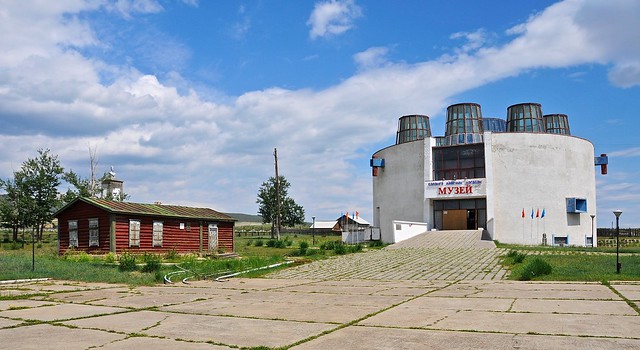 |
| An old Russian-style building that was the first workplace of independence hero Sukhbaatar (after whom many places are named Sukhbaatar) and the Altanbulag museum. It was pretty interesting. |
Back in Sukhbaatar
After returning from Altanbulag, the weather changed. It became cloudier and quite windy, with rainstorms in the distance.
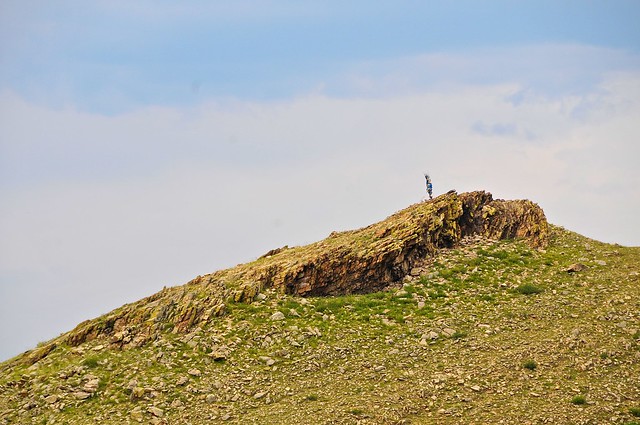 |
| Looking up at an ovoo from the town. |
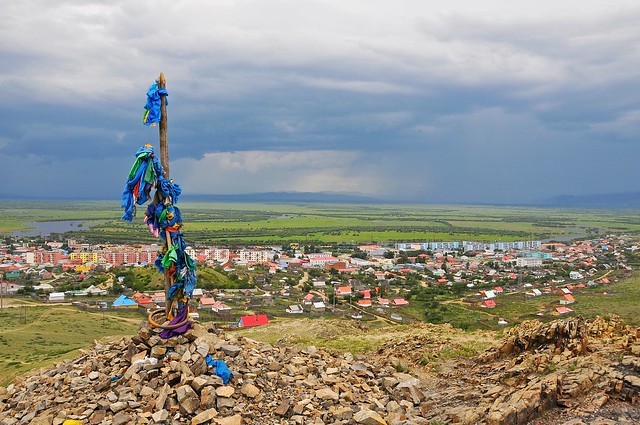 |
| View from the ovoo looking back down at Sukhbaatar. |
 |
| Panorama from high up on ridge next to town. |
 |
| Ridge with rain in the background. |
 |
| I couldn't figure out exactly what she was gathering, but I'm pretty sure they were herbs or vegetables for dinner. |
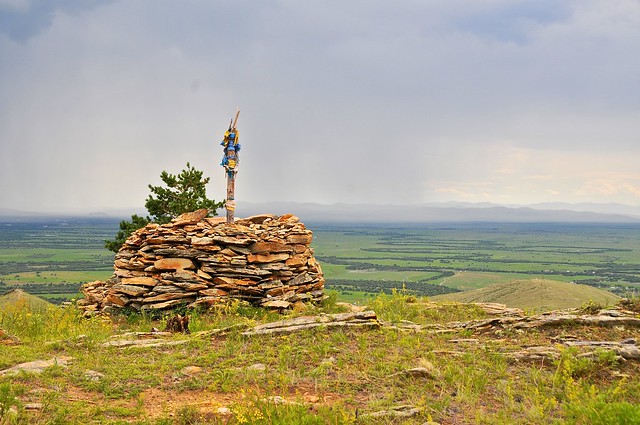 |
| An unusual ovoo on one of the ridges. |
 |
| Mongolian roads north of town. |
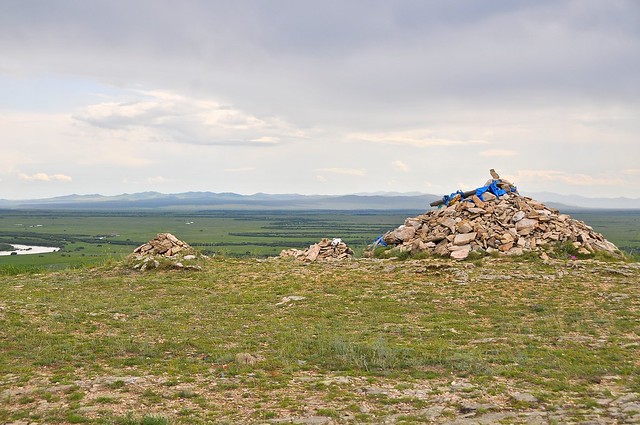 |
| There's an ovoo or three on every ridge. |
 |
| Panorama from ridge above Sukhbaatar. |
 |
| Looking out over Sukhbaatar and the Orkhon river. |
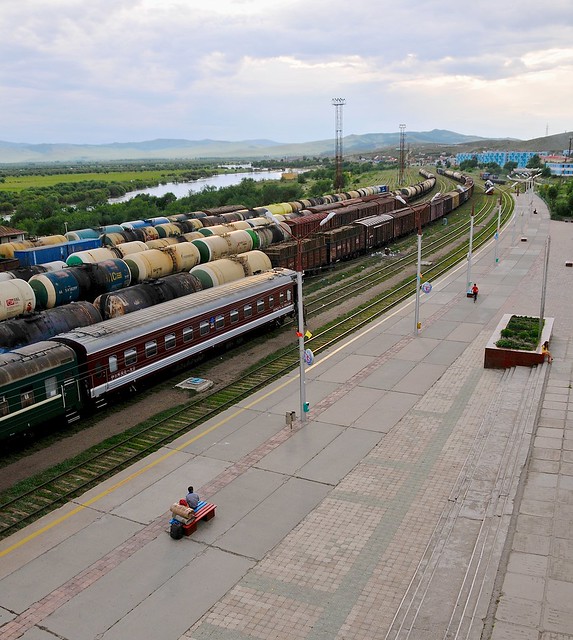 |
| View of the railway station, looking north from the hallway outside my hotel room. |





















































Thank u for sharing your thoughts. i pretty agree with you about lack of care, but at least it's natural compared other country. although our Mongolians seem rude, but they are kind. i hope you will go to other beautiful place where located in Mongolia.
ReplyDelete